On March 17th, many Kansas City sports fans rejoiced, as the Royals brought back Zack Greinke, the former Royals ace who won an AL Cy Young back in 2009:
We have signed RHP Zack Greinke to a one-year contract.
Welcome back, Zack! pic.twitter.com/sU81s7Sybs
— Kansas City Royals (@Royals) March 16, 2022
Last season, the Royals starting pitching staff had their fair share of ups and downs, as many young pitchers, such as Daniel Lynch, Kris Bubic, Brady Singer, Carlos Hernández, and Jackson Kowar, struggled at various points in their first full season at the Major League level. Overall, the starting staff ranked 24th in the league in ERA, 27th in WHIP, and 30th in BB/9.
Greinke brings a veteran presence and a proven track record that this Royals rotation needs, especially if the club wants to improve upon their 74-88 record from 2021.
That being said, while Greinke is expected to be the Royals’ Opening Day starter, via Roster Resource, this is not the same pitcher who left Kansas City after the 2010 season.
The 38-year-old pitcher is coming off a down 2021 season that could be considered one of the worst of his career. His 4.16 ERA is his highest since his 2016 season in Arizona (4.37 that year). Additionally, his 1.3 fWAR was his worst mark in that category since 2006 when he only pitched 6.1 innings for the Royals as a 22-year-old.
While Greinke is a great fit for the Royals rotation on a “sentimental” basis, will he actually have an impact on the rotation in 2022 on the production end?
The answer is he can, but the key to success in Kansas City will be how his four-seam fastball fares in 2022.
Regression in Velocity and Spin Rate in 2021
As expected for any pitcher who is 38-years-old, Greinke has seen a decline in his four-seam fastball velocity over the past half-decade. Last year, his four-seamer averaged 88.9 MPH, the second-slowest it’s been since 2015, which ranked him in the bottom seventh percentile on the pitch last year, according to Baseball Savant.
In the table below, Greinke has seen a pretty linear decline since 2015. His fastball velocity has not just regressed, but the spin on the pitch has also suffered, though not as dramatically as the velocity.
Surprisingly, even though Greinke has seen a 3.5 MPH decline on his four-seamer since 2015, he still utilizes the pitch on a primary basis. His four-seamer was not only his most utilized pitch in 2021 but it was only thrown 4.8 percent less than 2015 when his four-seamer averaged 3.5 MPH more than his 2021 version.
In addition to his four-seamer averaging under 89 MPH last season, the second-consecutive season the pitch has done so, it also averaged a career-low in spin rate.
Here’s a look at the annual trend of average spin on his four-seamer since 2015.
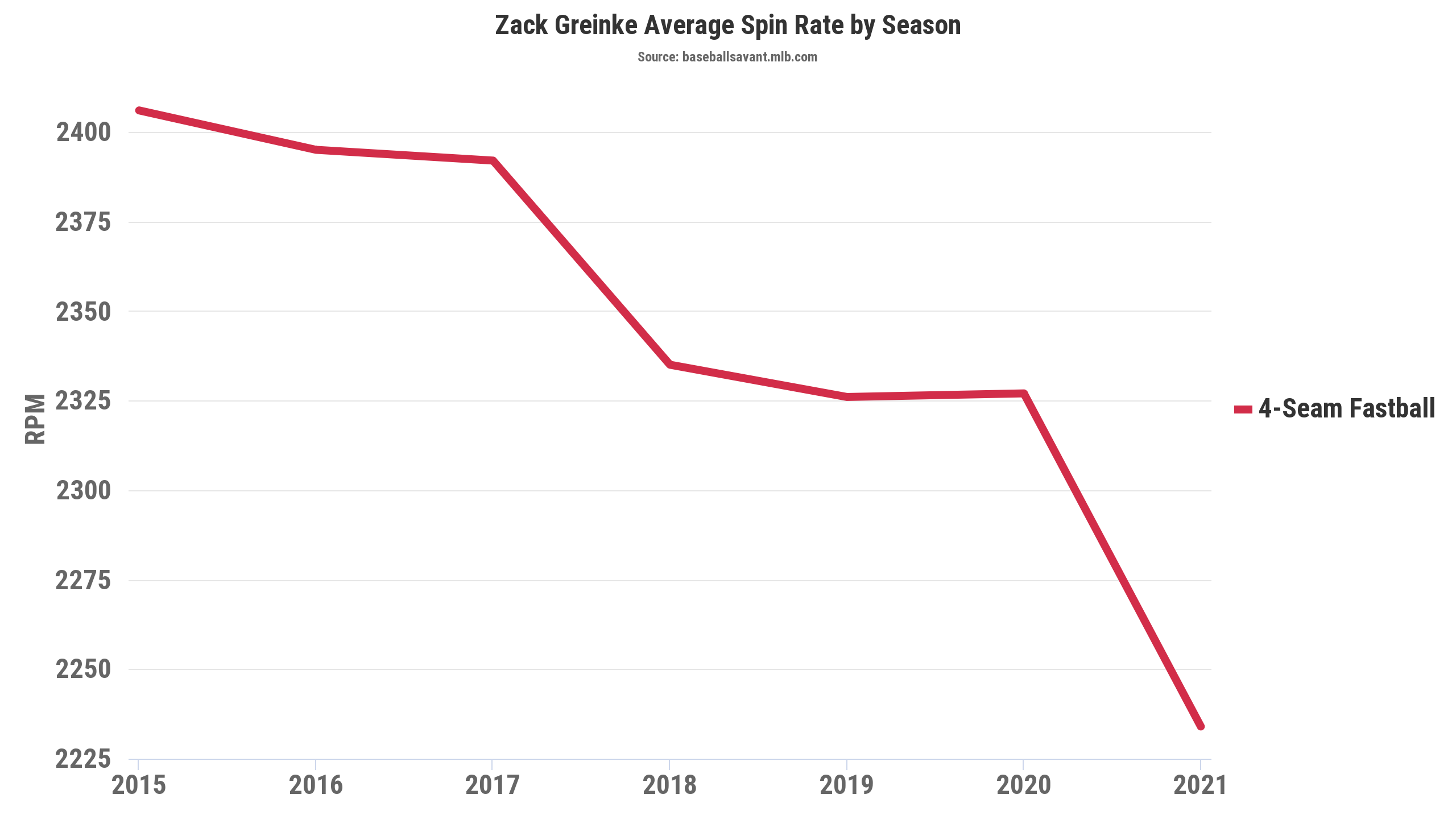
Greinke’s four-seamer was already starting to see a decline in the average spin rate from 2015 to 2018. However, the drop last year of 93 RPM in 2021 from his 2020 mark was a pretty significant and concerning regression.
Additionally, the dip in four-seamer spin rate also seemed to correlate with other not-so-positive regressions in other categories, specifically average exit velocity and launch angles on batted balls.
The main outlier from those categories listed in the table above was his put-away rate, as Greinke saw a 2.8 percent increase on the four-seamer when it came to putting away batters in two-strike counts. Additionally, the 19.8 percent put away rate last season was the third-best mark for him in that category over the past seven seasons.
A big contributor to that put-away prowess on the pitch, despite it seeing heavy regressions in other categories, could be credited to Greinke’s ability to command strikes on the pitch, especially of the called strike variety.
The Four-Seamer and Strikes
Since 2018, Greinke’s four-seamer has not generated much in terms of swinging strikes, which isn’t a surprise considering the pitch’s low velocity in comparison to other four-seamers around the league.
What is interesting to note though is that while Greinke doesn’t produce a whole lot of whiffs with the pitch, he still has been able to generate a lot of called strikes on the pitch, which was not just the case last season, but since 2018.
Here’s a look at his swinging strike, called strike, and CSW (called strike plus whiff) rates over the past four seasons, and how it compares with the velocity of his four-seamer during each respective season.
According to Pitcher List data, Greinke’s swinging strike rate ranked in the 194th percentile, which is incredibly pedestrian and actually correlates with his four-seam velocity, which also ranks in the same percentile. On the flip side, his CSW rate ranked in the upper 21st percentile, which is more elite.
Thus, when it comes to effectively locating the pitch, there aren’t a lot of pitchers in the game currently who are better than Greinke.
What’s interesting to observe is how differently he commands the four-seamer when it comes to generating called and swinging strikes.
Here’s a look at the pitch heatmap below which tracks all the swinging strikes he generated from 2021. As expected, swinging strikes did not constitute a high percentage of the strikes he produced a season ago, and that is further proven by the inconsistency of the red dots all over the strike zone.
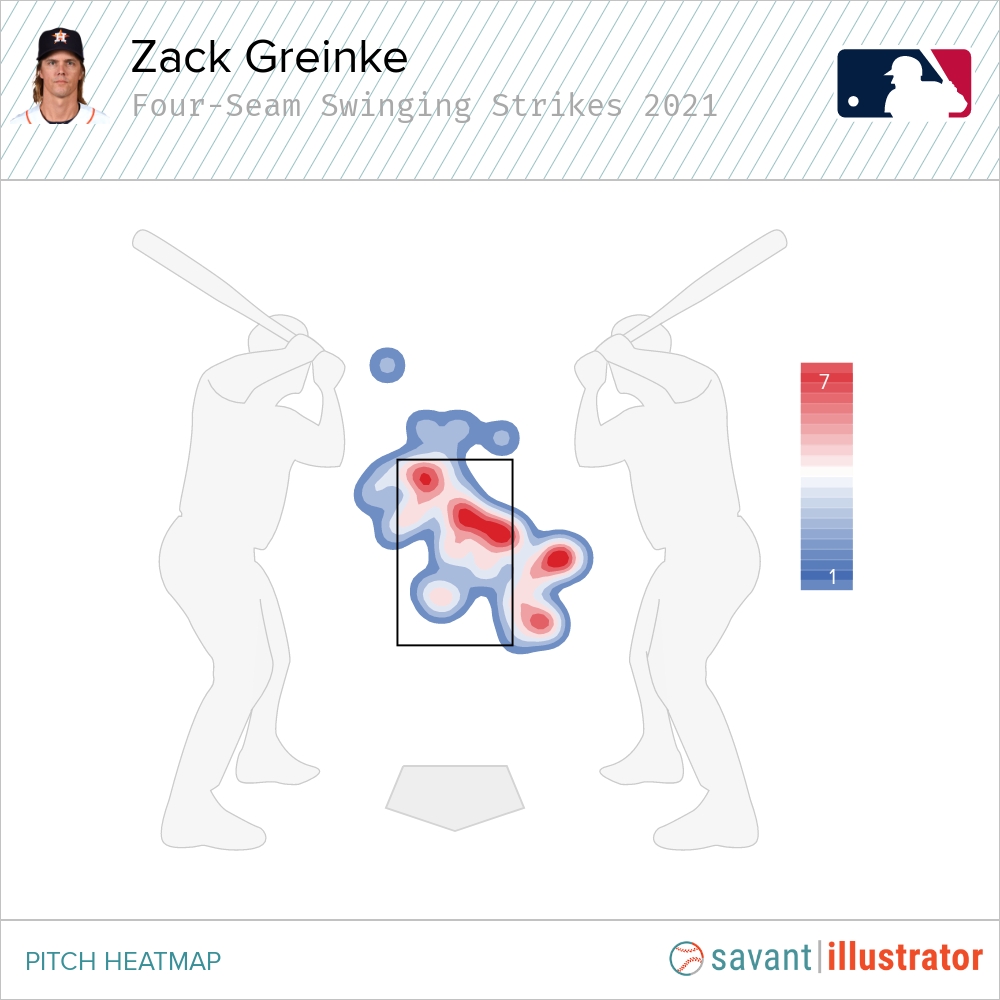
Granted, Greinke pretty much locates the pitch in areas one would expect when it came to getting swings and misses (i.e up in the zone or just on the outside, but still middle-up).
Here’s a look at Greinke throwing the pitch up in the strike zone around one of the upper red dot areas to Oakland’s Matt Olson on Opening Day last year and generating a whiff.
https://gfycat.com/fastquestionableclownanemonefish
While he did generate swinging strikes when throwing in the upper parts of the strike zone with the pitch, it also got hit hard in that area when batters did make contact.
In the heatmap below, take a look at the red dot areas where hitters produced base hits off of Greinke when he threw his four-seam fastball last season.
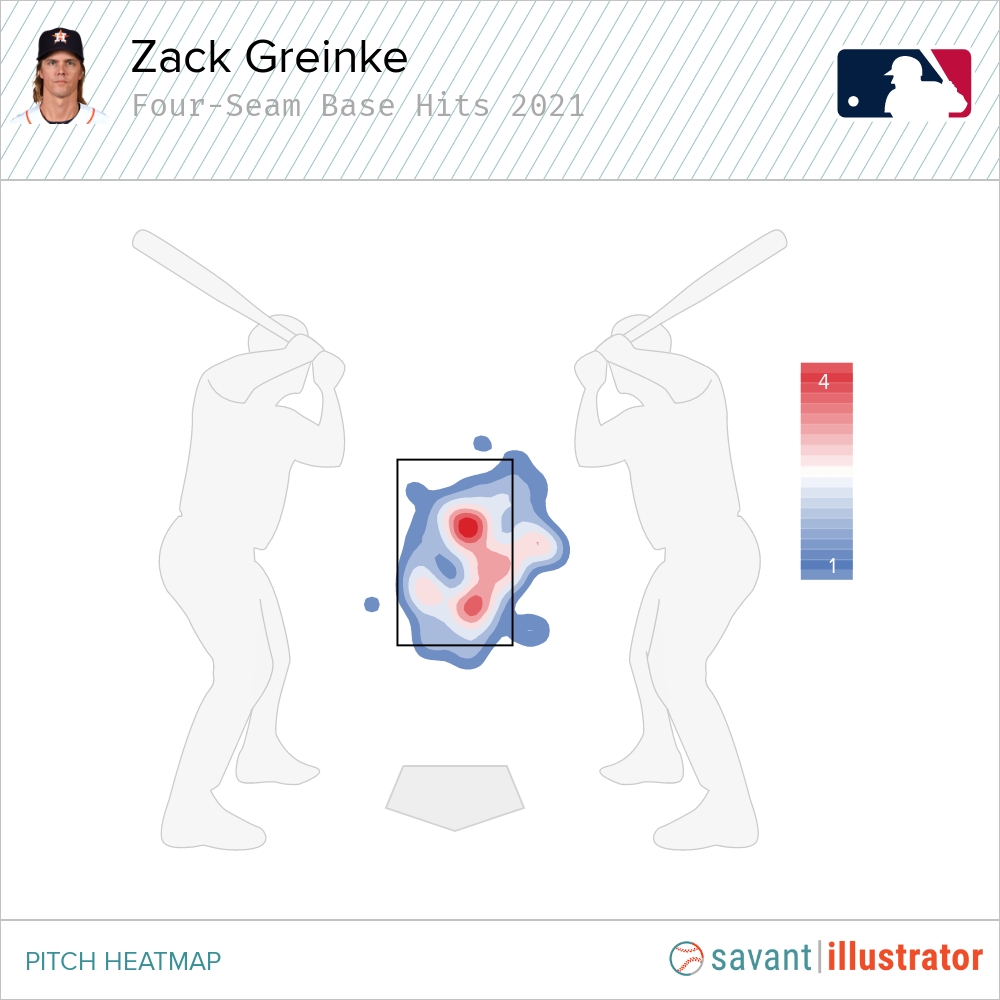
Yes, he was able to get Olson to swing and miss in that Opening Day contest last April. However, in a June game against the Blue Jays, Greinke tries to locate his four-seamer up and away in the zone (much like he did against Olson). Instead, Randal Grichuk blasts the ball over the deep left-center field wall.
https://gfycat.com/recentconcreteboa
An intriguing trend that emerges from Greinke’s fastball data is the location of Greinke’s called strikes on the four-seamer, and how they differed in where they were primarily thrown, in comparison to the swinging strike areas.
Let’s take a look at Greinke’s called strike heatmap from last season:
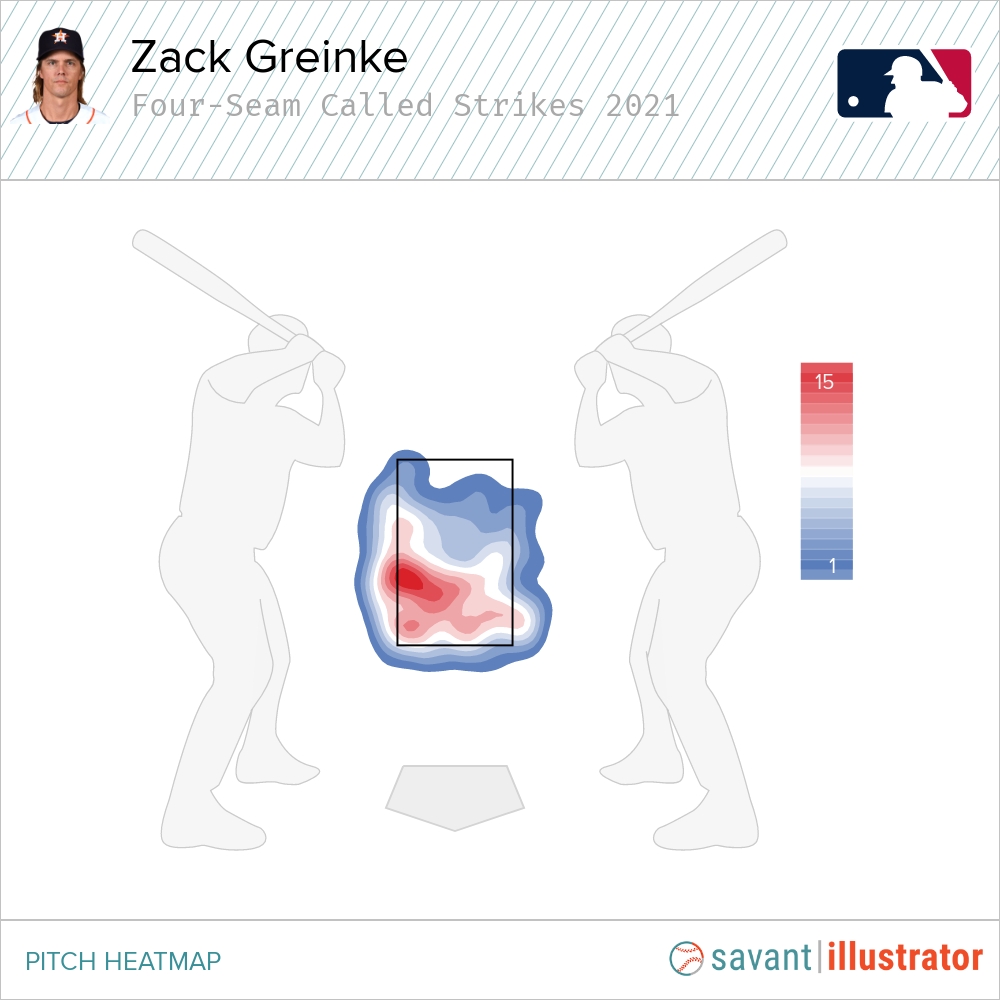
Now, compare that to the batting average zone chart below, and let’s pay attention to where the red dot areas from the heatmap correlate on the zone chart on four-seam fastballs from 2021:
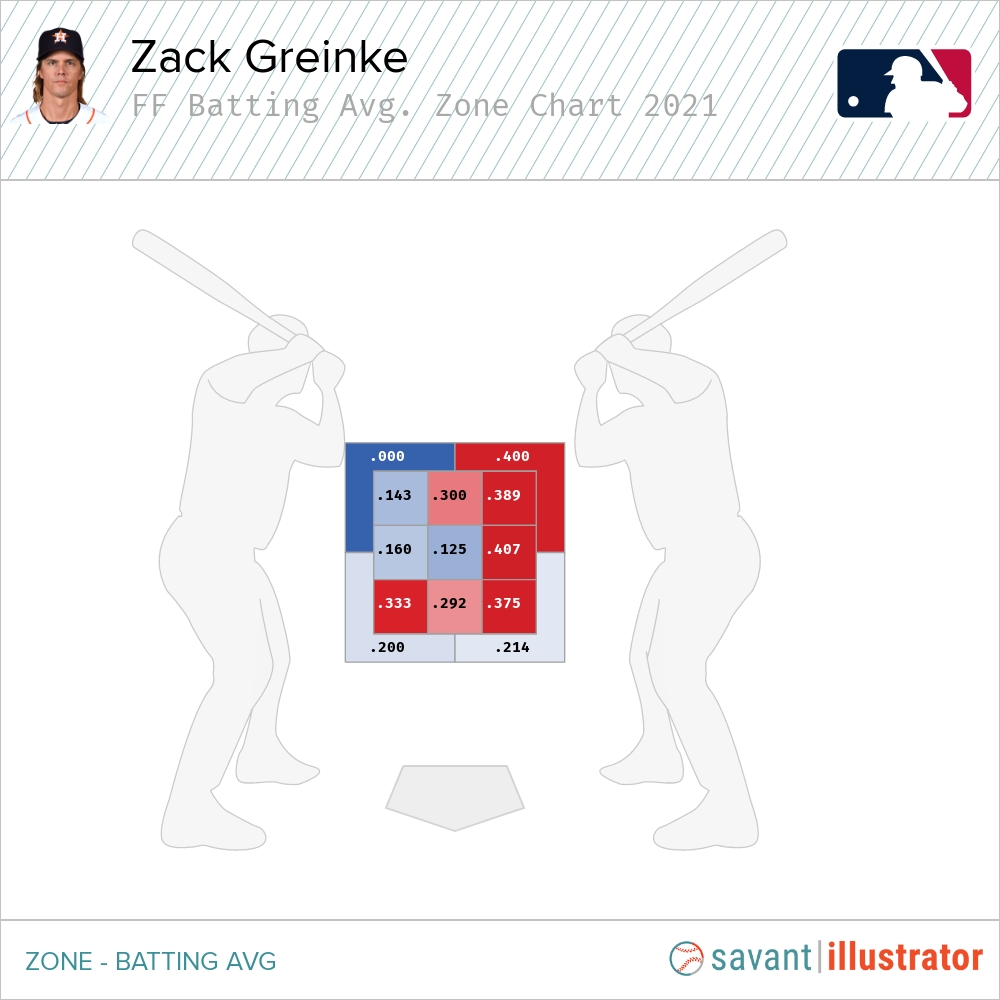
In the glove-side areas of the strike zone (3, 6, 9), Greinke’s four-seamer pretty much got shelled. That is evidenced by hitters posting a .389 average in zone 3, a .407 average in zone 6, and a .375 average in zone 9.
On the other hand, in those middle and low arm-side areas of the strike zone, the batting average numbers are more palatable. Yes, hitters posted a .333 average last year on four-seamers thrown in zone 7. However, he made up for it by limiting hitters to a .160 average in zone 4, .200 average in zone 13, and .143 average in zone 1.
He also had success freezing batters in two-strike counts with the four-seamer when thrown in those areas in 2021.
Here’s an example of Greinke getting the called strike three against Albert Pujols when the Astros played the Dodgers back on May 25th at Minute Maid Park:
https://gfycat.com/rectangulartattereddowitcher
Greinke may not have the plus velocity or spin on his four-seamer anymore, and that certainly has deflated his swinging strike rates in the process over the past few seasons.
However, Greinke is still elite when it comes to generating called strikes with his four-seamer.
In addition, how he pairs it with his changeup, his second most-thrown pitch in 2021, also could give Royals and fantasy baseball fans insight into whether his four-seamer will continue to generate called strikes at a high rate in 2022.
The Four-Seamer and Changeup Sequence
There’s no question that Greinke’s changeup has been his most effective pitch over the past four seasons.
Here’s a look at the run value data on the pitch, and it is easy to see how it has been a plus pitch since 2018, as it has accumulated a total run value of minus-45 over that four-year span.
In addition, while Greinke’s four-seamer has been an effective pitch when it comes to generating called strikes, the changeup has seen an inverse pattern. This can be seen in the table below:
With the exception of 2020, the changeup has been an effective pitch for Greinke over the past four seasons when it comes to generating swings and misses (as well as groundballs). However, on a called-strike end? The called strike rate has been under 10 percent on the changeup for three out of the past four years (with the exception of the fluky 2020, of course).
What makes the changeup even more fascinating, especially when keeping the four-seamer in mind, is when one takes a look at where Greinke typically locates his changeup, as seen in the pitch heatmap below:
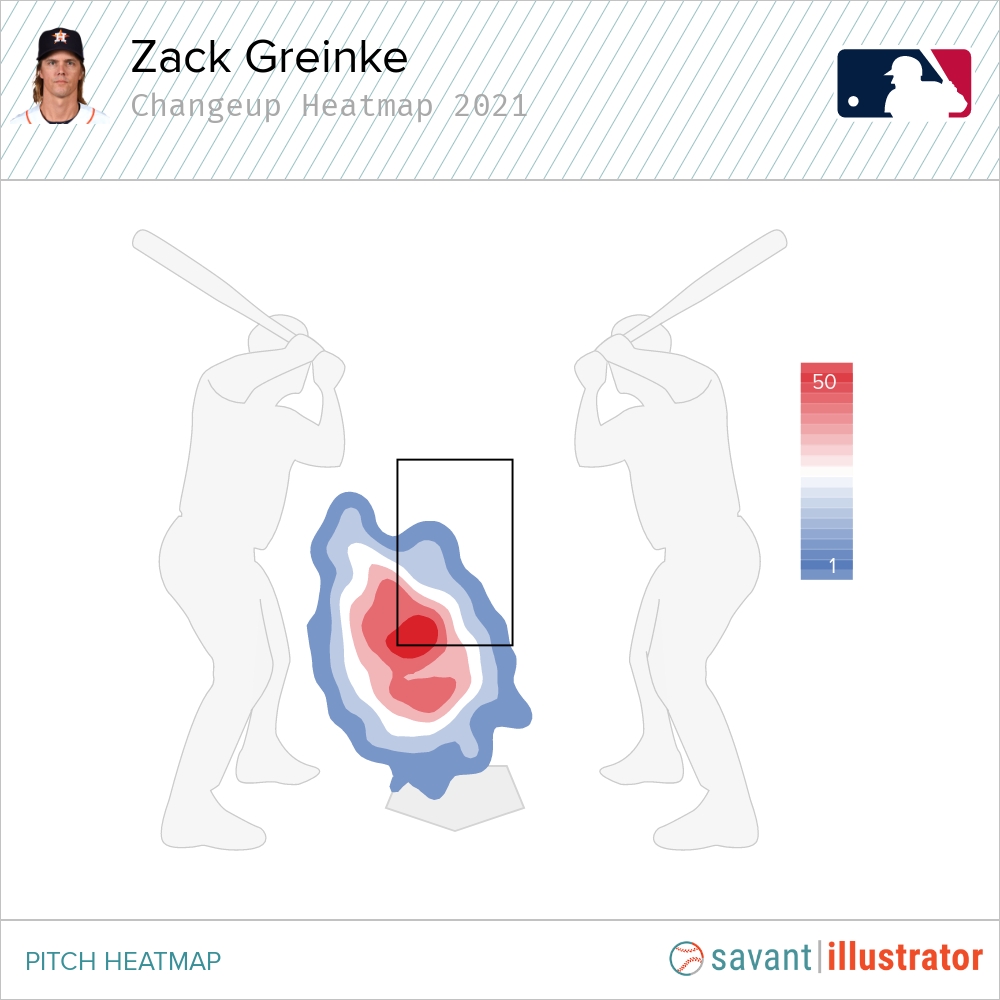
Notice that Greinke throws a lot of changeups in that zone 7 area, which is where he garnered a lot of called strikes with his four-seam fastball in 2021. While there isn’t a tremendous difference in velocity from the four-seamer and changeup (2.5 MPH to be specific), the fact that Greinke sequences those two pitches together in the same areas has been a recipe for success.
Here’s an example of Max Muncy most likely looking for a four-seamer in zone 7 of the strike zone. Instead, Greinke throws the changeup, and Muncy swings over the pitch and strikes out in the process:
https://gfycat.com/harmoniouslividaldabratortoise
The sequencing also seems to be legit, especially when one breaks down his pitch pie chart, via Baseball Savant. Take a look at how many areas of the strike zone where the changeup and four-seamer are both thrown a frequent amount:
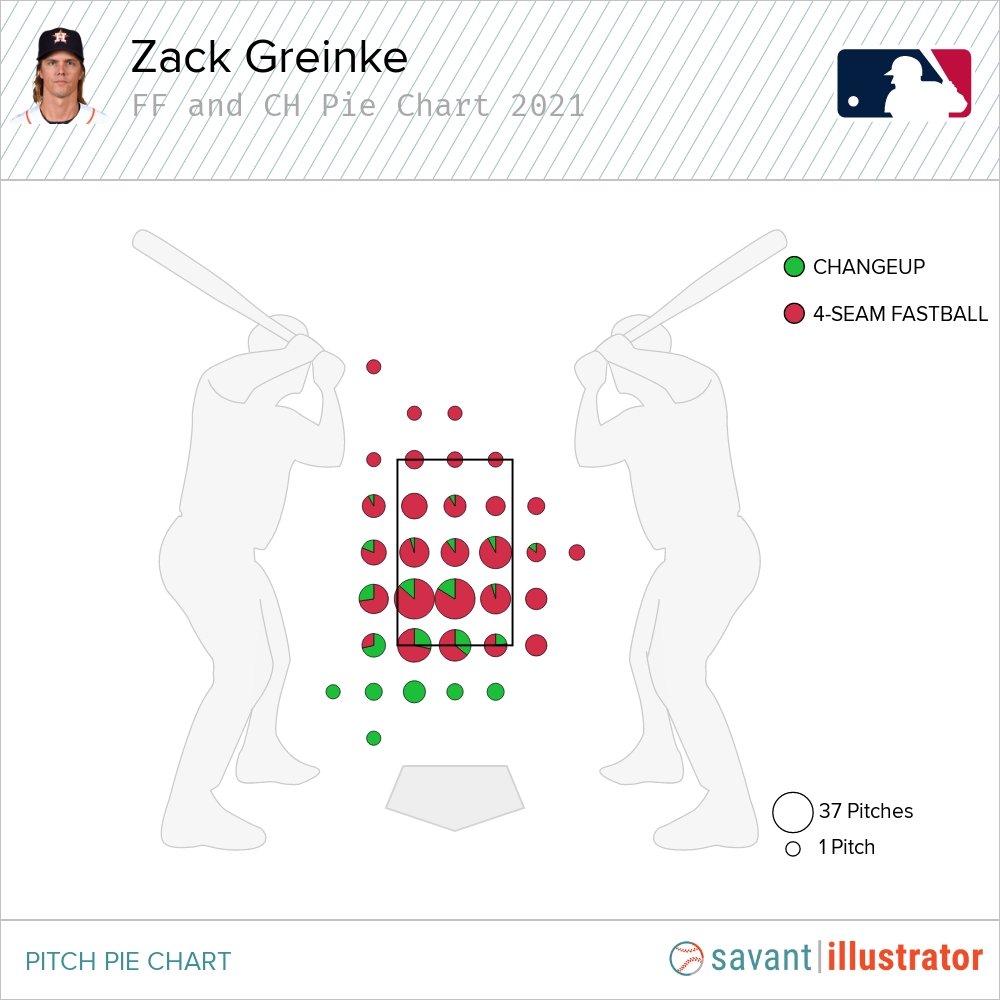
Greinke throws the four-seamer and changeup frequently enough in those lower parts of the strike zone, which in turn makes hitters chase those changeups that do drop out of the strike zone. Not only is that evidenced in the chart above, but also the 42.1 O-Swing (swings outside the strike zone) percentage in 2021.
How Greinke utilizes this four-seamer and changeup mix in 2022 will undoubtedly be key to his success at the top of the Royals rotation, especially at the beginning of the season.
Final Thoughts
As of March 18th, Greinke’s ADP is No. 274, according to Fantasy Pros. He also is rostered in 63 percent of Yahoo! leagues and 36 percent of ESPN leagues, which is a slight bump up from where he was going in drafts prior to the Royals signing.
Therefore, it appears that many fantasy players aren’t totally high on Greinke’s outlook in 2022. Furthermore, some Royals fans may be feeling the same, especially considering that Greinke may be entering the final year or two of his illustrious career. Many will see the sub-89 MPH four-seamer, and think that he won’t have much impact as a starting pitcher like in seasons past.
However, Royals and fantasy baseball fans shouldn’t be quick to dismiss Greinke just on his surface-level metrics.
His four-seamer can still be a pretty productive pitch, and Greinke possesses a dangerous 1-2 pitch combo when he pairs the four-seamer effectively with his changeup. That was demonstrated in the data above and should continue to be the case, as long as Greinke still maintains that pinpoint command that he has been known for over the course of his career.
Additionally, Greinke will continue to have a stellar defense behind him, which will play well into his groundball-inducing tendencies. Last season, according to Statcast’s OAA metric, the Royals rated as the 6th-best defense in baseball.
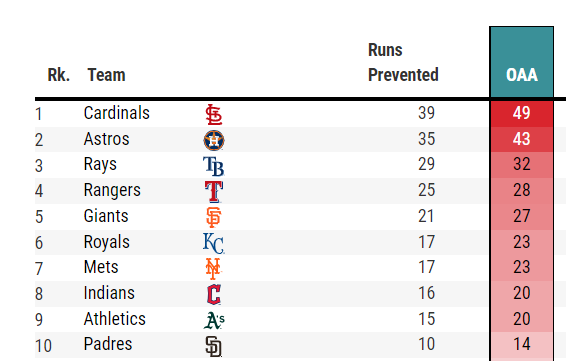
The Royals’ defense will only be better in 2022, especially with nearly every effective fielder returning, and Jorge Soler and Hunter Dozier no longer playing in right field and third base, respectively.
There is a lot of nostalgia and sentimentality associated with Greinke’s return to Kansas City. His presence and experience will definitely help this Royals rotation, especially with so much invested in the Royals’ young pitching staff.
That being said, Greinke still has something left in the tank…
And his four-seamer, especially at the beginning of the year, could give Royals and fantasy baseball fans an indication of how effective his 2022 campaign will be.
Photos by Mark LoMoglio/Icon Sportswire; Mr.Konerko/Wikimedia Commons | Adapted by Drew Wheeler (@drewisokay on Twitter)

